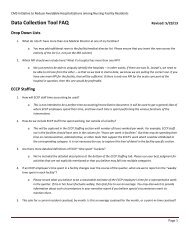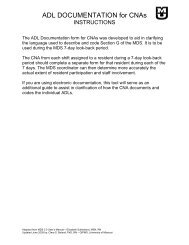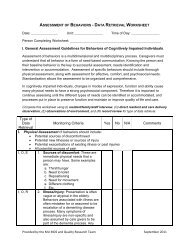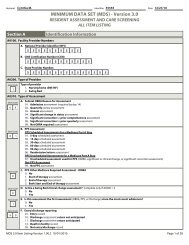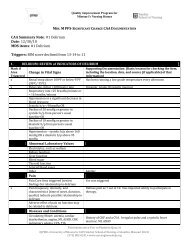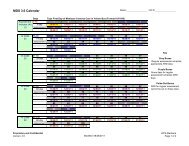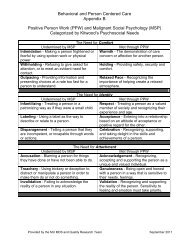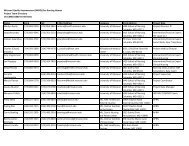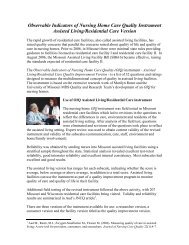National Guideline Clearinghouse (NGC). Guideline synthesis
National Guideline Clearinghouse (NGC). Guideline synthesis
National Guideline Clearinghouse (NGC). Guideline synthesis
You also want an ePaper? Increase the reach of your titles
YUMPU automatically turns print PDFs into web optimized ePapers that Google loves.
NATIONAL GUIDELINE CLEARINGHOUSE (<strong>NGC</strong>)<br />
GUIDELINE SYNTHESIS<br />
PRESSURE ULCER PREVENTION<br />
<strong>Guideline</strong>s<br />
1. Hartford Institute for Geriatric Nursing (HIGN). Preventing pressure<br />
ulcers and skin tears. In: Capezuti E, Zwicker D, Mezey M, Fulmer T,<br />
editor(s). Evidence based geriatric nursing protocols for best practice. 3rd ed.<br />
New York (NY): Springer Publishing Company, Inc.; 2008 Jan. p. 403-29. [91<br />
references]<br />
2. Registered Nurses Association of Ontario (RNAO). Risk assessment &<br />
prevention of pressure ulcers. Toronto (ON): Registered Nurses Association of<br />
Ontario (RNAO); 2005 Mar. 80 p. [70 references]<br />
INTRODUCTION<br />
A direct comparison of the Hartford Institute for Geriatric Nursing (HIGN) and the<br />
Registered Nurses Association of Ontario (RNAO) recommendations for prevention<br />
of pressure ulcers is provided in the tables below.<br />
Table 1 provides a quick-view glance at the primary interventions considered<br />
by each group.<br />
Table 2 provides a comparison of the overall scope of both guidelines.<br />
Table 3 provides a more detailed comparison of the specific recommendations<br />
offered by each group for the topics under consideration in this <strong>synthesis</strong>,<br />
including:<br />
Assessment<br />
Prevention<br />
Skin Care and Protection<br />
Positioning and Pressure-Relieving Devices<br />
Nutrition<br />
Patient, Caregiver and Professional Education<br />
Other Prevention Interventions<br />
Table 4 lists the potential benefits and harms associated with the<br />
implementation of each guideline as stated in the original guidelines.<br />
Table 5 presents the rating schemes used by the guideline groups to rate the<br />
level of evidence and/or the strength of the recommendations.<br />
Following the content comparison tables, the areas of agreement and areas of<br />
differences among the guidelines are identified.<br />
Abbreviations<br />
1 of 17
HIGN, Hartford Institute for Geriatric Nursing<br />
NPUAP, <strong>National</strong> Pressure Ulcer Advisory Panel<br />
RNAO, Registered Nurses Association of Ontario<br />
TABLE 1: COMPARISON OF INTERVENTIONS AND PRACTICES CONSIDERED<br />
(" " indicates topic is addressed)<br />
HIGN<br />
(2008)<br />
RNAO<br />
(2005)<br />
ASSESSMENT<br />
PREVENTION<br />
Skin Care & Protection<br />
Positioning & Pressure-Relieving Devices<br />
Nutrition<br />
Environmental Modification<br />
Patient, Carer & Professional Education<br />
Other Prevention Interventions<br />
TABLE 2: COMPARISON OF SCOPE AND CONTENT<br />
Objective and Scope<br />
HIGN<br />
(2008)<br />
To provide instruction regarding pressure ulcer risk assessment<br />
To identify risk factors associated with pressure ulcer development<br />
To explain the meaning of an individual's risk assessment score<br />
To present a comprehensive, holistic plan to prevent pressure<br />
ulcers in individuals at risk<br />
RNAO<br />
(2005)<br />
To present nursing best practice guidelines for risk assessment and<br />
prevention of pressure ulcers<br />
To assist nurses who work in diverse practice settings to identify<br />
adults who are at risk of pressure ulcers and provide direction to<br />
nurses in defining early interventions for pressure ulcer prevention,<br />
2 of 17
and to manage Stage I pressure ulcers<br />
Target Population<br />
HIGN<br />
(2008)<br />
United States<br />
Older adults with identified intrinsic and/or extrinsic risk factors for<br />
pressure ulcers<br />
RNAO<br />
(2005)<br />
Canada<br />
Adults from diverse practice settings who are at risk of developing<br />
pressure ulcers<br />
Intended Users<br />
HIGN<br />
(2008)<br />
RNAO<br />
(2005)<br />
Advanced Practice Nurses<br />
Allied Health Personnel<br />
Health Care Providers<br />
Health Plans<br />
Hospitals<br />
Managed Care Organizations<br />
Nurses<br />
Patients<br />
Students<br />
Advanced Practice Nurses<br />
Nurses<br />
TABLE 3: COMPARISON OF RECOMMENDATIONS FOR THE ASSESSMENT AND<br />
PREVENTION OF PRESSURE ULCERS<br />
Assessment<br />
HIGN<br />
(2008)<br />
Parameters of Assessment<br />
Assess for intrinsic and extrinsic risk factors<br />
Braden Scale risk score<br />
18 or below for elderly and persons with darkly pigmented<br />
skin<br />
16 or below for other adults<br />
Nursing Care Strategies and Interventions<br />
3 of 17
Risk Assessment Documentation<br />
On admission to a facility<br />
Reassessment intervals whenever the client's condition changes<br />
and based on patient care setting:<br />
Acute care: every 48 hrs<br />
Long-term care: weekly for first 4 weeks, then monthly to<br />
quarterly<br />
Home care: every nursing visit<br />
Use a reliable and standardized tool for doing a risk<br />
assessment such as the Braden Scale (see Try This:<br />
Predicting Pressure Ulcer Risk).<br />
Document risk assessment scores and implement prevention<br />
protocols based on cutscore.<br />
General Care Issues and Interventions<br />
Culturally sensitive early assessment for Stage I pressure ulcers in<br />
clients with darkly pigmented skin<br />
Use a halogen light to look for skin color changes--may be<br />
purple hues.<br />
Compare skin over bony prominences to surrounding skin--<br />
may be boggy or stiff, warm or cooler.<br />
RNAO<br />
(2005)<br />
Assessment<br />
A head-to-toe skin assessment should be carried out with all clients at<br />
admission, and daily thereafter for those identified at risk for skin<br />
breakdown. Particular attention should be paid to vulnerable areas,<br />
especially over bony prominences.<br />
(Level of Evidence = IV)<br />
The client's risk for pressure ulcer development is determined by the<br />
combination of clinical judgment and the use of a reliable risk<br />
assessment tool. The use of a tool that has been tested for validity and<br />
reliability, such as the Braden Scale for Predicting Pressure Sore Risk, is<br />
recommended. Interventions should be based on identified intrinsic and<br />
extrinsic risk factors and those identified by a risk assessment tool,<br />
such as Braden's categories of sensory perception, mobility, activity,<br />
moisture, nutrition, friction, and shear. Risk assessment tools are<br />
useful as an aid to structure assessment.<br />
(Level of Evidence = IV)<br />
Clients who are restricted to bed and/or chair, or those experiencing<br />
surgical intervention, should be assessed for pressure, friction, and<br />
shear in all positions and during lifting, turning, and repositioning.<br />
4 of 17
(Level of Evidence = IV)<br />
All pressure ulcers are identified and staged using the NPUAP criteria.<br />
(Level of Evidence = IV)<br />
If pressure ulcers are identified, utilization of the RNAO best practice<br />
guideline Assessment and Management of Stage I to IV Pressure Ulcers<br />
is recommended.<br />
(Level of Evidence = IV)<br />
All data should be documented at the time of assessment and<br />
reassessment.<br />
(Level of Evidence = IV)<br />
PREVENTION<br />
Skin Care and Protection<br />
HIGN<br />
(2008)<br />
Agency for Health Care Policy and Research (now known as the Agency<br />
for Healthcare Research and Quality, AHRQ) (AHCPR, 1992) prevention<br />
recommendations:<br />
Assess skin daily<br />
Clean skin at time of soiling--avoid hot water and irritating cleaning<br />
agents<br />
Use moisturizers on dry skin<br />
Do not massage bony prominences<br />
Protect skin of incontinent clients from exposure to moisture<br />
Use lubricants, protective dressings, and proper lifting techniques<br />
to avoid skin injury from friction/shear during transferring and<br />
turning of clients<br />
Other care issues and interventions<br />
Do not massage reddened bony prominences<br />
Avoid drying out the patient's skin, use lotion after bathing<br />
Avoid hot water and soaps that are drying when bathing elderly.<br />
Use body wash and skin protectant (Hunter et al., 2003 [Level<br />
III])<br />
Manage moisture<br />
Manage moisture by determining the cause, use absorbent<br />
pad that wicks moisture<br />
Offer a bedpan or urinal in conjunction with turning<br />
schedules<br />
5 of 17
RNAO<br />
(2005)<br />
A head-to-toe skin assessment should be carried out with all clients at<br />
admission, and daily thereafter for those identified at risk for skin<br />
breakdown. Particular attention should be paid to vulnerable areas,<br />
especially over bony prominences.<br />
(Level of Evidence = IV)<br />
Avoid massage over bony prominences.<br />
(Level of Evidence = IIb)<br />
Protect and promote skin integrity:<br />
Ensure hydration through adequate fluid intake.<br />
Individualize the bathing schedule.<br />
Avoid hot water and use a pH balanced, non-sensitizing skin<br />
cleanser.<br />
Minimize force and friction on the skin during cleansing.<br />
Maintain skin hydration by applying non-sensitizing, pH balanced,<br />
lubricating moisturizers and creams with minimal alcohol content.<br />
Use protective barriers (e.g., liquid barrier films, transparent films,<br />
hydrocolloids) or protective padding to reduce friction injuries.<br />
(Level of Evidence = IV)<br />
Protect skin from excessive moisture and incontinence:<br />
Assess and manage excessive moisture related to body fluids (e.g.,<br />
urine, feces, perspiration, wound exudates, saliva)<br />
Gently cleanse skin at time of soiling. Avoid friction during care<br />
with the use of a spray perineal cleaner or soft wipe.<br />
Minimize skin exposure to excess moisture. When moisture cannot<br />
be controlled, use absorbent pads, dressings, or briefs that wick<br />
moisture away from the skin. Replace pads and linens when damp.<br />
Use topical agents that provide protective barriers to moisture.<br />
If unresolved skin irritation exists in a moist area, consult with the<br />
physician for evaluation and topical treatment.<br />
Establish a bowel and bladder program.<br />
(Level of Evidence = IV)<br />
Positioning and Pressure-Relieving Devices<br />
HIGN<br />
(2008)<br />
Agency for Health Care Policy and Research (now known as the Agency<br />
for Healthcare Research and Quality, AHRQ) (AHCPR, 1992) prevention<br />
recommendations:<br />
Turn and position bed-bound clients every 2 hours if consistent<br />
with overall care goals.<br />
Use a written schedule for turning and repositioning clients.<br />
6 of 17
Use pillows or other devices to keep bony prominences from direct<br />
contact with each other.<br />
Raise heels of bed-bound clients off the bed; do not use donut-type<br />
devices (Gilcreast et al., 2005 [Level II]).<br />
Use a 30 degree lateral side lying position; do not place client<br />
directly on their trochanter.<br />
Keep head of the bed at lowest height possible.<br />
Use lifting devices (Trapeze, bed linen) to move clients rather than<br />
dragging them in bed during transfers and position changes.<br />
Use pressure-reducing devices (static air, alternating air, gel, water<br />
mattresses) (Iglesias et al., 2006 [Level II]; Hampton & Collins,<br />
2005 [Level II]).<br />
Reposition chair or wheelchair bound clients every hour. In<br />
addition, if clients are capable, have them do small weight shifts<br />
every 15 minutes.<br />
Use a pressure-reducing device (not a donut) for chair-bound<br />
clients.<br />
Other care issues and interventions<br />
Keep the patient as active as possible; encourage mobilization.<br />
Avoid positioning the patient directly on their trochanter.<br />
Avoid use of doughnut-shaped devices.<br />
Manage friction and shear:<br />
Elevate the head of the bed no more than 30 degrees.<br />
Have the patient use a trapeze to lift self up in bed.<br />
Staff should use a lift sheet or mechanical lifting device to<br />
move patient.<br />
Protect high-risk areas such as elbows, heels, sacrum, back<br />
of head from friction injury.<br />
Interventions Linked to Braden Risk Scores (Adapted from Ayello &<br />
Braden, 2001)<br />
Prevention protocols linked to Braden Risk are as follows:<br />
At risk: score of 15 to 18<br />
Frequent turning, consider every 2 hour schedule, use a written<br />
schedule<br />
Maximize patient's mobility.<br />
Protect patient's heels.<br />
Use a pressure-reducing support surface if patient is bed- or chairbound.<br />
Moderate risk: score of 13 to 14<br />
Same as above but provide foam wedges for 30 degree lateral<br />
position<br />
7 of 17
High risk: score of 10 to 12<br />
Same as above but add the following:<br />
Increase the turning frequency.<br />
Do small shifts of position.<br />
Very high risk: score of 9 or below<br />
Same as above but use a pressure relieving surface<br />
Manage moisture, nutrition, and friction/shear.<br />
RNAO<br />
(2005)<br />
For clients with an identified risk for pressure ulcer development,<br />
minimize pressure through the immediate use of a positioning<br />
schedule.<br />
(Level of Evidence = IV)<br />
Use proper positioning, transferring, and turning techniques. Consult<br />
Occupational Therapy/Physiotherapy (OT/PT) regarding transfer and<br />
positioning techniques and devices to reduce friction and shear and to<br />
optimize client independence.<br />
(Level of Evidence = IV)<br />
Clients at risk of developing a pressure ulcer should not remain on a<br />
standard mattress. A replacement mattress with low interface pressure,<br />
such as high-density foam, should be used.<br />
(Level of Evidence = Ia)<br />
For high risk clients experiencing surgical intervention, the use of<br />
pressure-relieving surfaces intraoperatively should be considered.<br />
(Level of Evidence = Ia)<br />
For individuals restricted to bed:<br />
Utilize an interdisciplinary approach to plan care.<br />
Use devices to enable independent positioning, lifting, and<br />
transfers (e.g., trapeze, transfer board, bed rails).<br />
Reposition at least every 2 hours or sooner if at high risk.<br />
Use pillows or foam wedges to avoid contact between bony<br />
prominences.<br />
Use devices to totally relieve pressure on the heels and bony<br />
prominences of the feet.<br />
A 30 degree turn to either side is recommended to avoid<br />
positioning directly on the trochanter.<br />
Reduce shearing forces by maintaining the head of the bed at the<br />
8 of 17
lowest elevation consistent with medical conditions and restrictions.<br />
A 30 degree elevation or lower is recommended.<br />
Use lifting devices to avoid dragging clients during transfer and<br />
position changes.<br />
Do not use donut type devices or products that localize pressure to<br />
other areas.<br />
(Level of Evidence = IV)<br />
For individuals restricted to chair:<br />
Use an interdisciplinary approach to plan care.<br />
Have the client shift weight every 15 minutes, if able.<br />
Reposition at least every hour if unable to shift weight.<br />
Use pressure-reducing devices for seating surfaces.<br />
Do not use donut type devices or products that localize pressure to<br />
other areas.<br />
Consider postural alignment, distribution of weight, balance,<br />
stability, support of feet, and pressure reduction when positioning<br />
individuals in chairs or wheelchairs.<br />
Refer to OT/PT for seating assessment and adaptations for special<br />
needs.<br />
(Level of Evidence = IV)<br />
Nutrition<br />
HIGN<br />
(2008)<br />
Manage nutrition:<br />
Consult a dietician and correct nutritional deficiencies<br />
Increase protein and calorie intake and A, C, or E vitamin<br />
supplements as needed (Houwing et al., 2003 [Level II]; Centers<br />
for Medicare and Medicaid Services [CMS], 2004 [Level V]).<br />
Offer a glass of water with turning schedules to keep patient<br />
hydrated.<br />
RNAO<br />
(2005)<br />
A nutritional assessment with appropriate interventions should be<br />
implemented on entry to any new health care environment and when<br />
the client's condition changes. If a nutritional deficit is suspected:<br />
Consult with a registered dietitian. (Level of Evidence = IV)<br />
Investigate factors that compromise an apparently well nourished<br />
individual's dietary intake (especially protein or calories) and offer<br />
him or her support with eating. (Level of Evidence = IV)<br />
Plan and implement a nutritional support and/or supplementation<br />
program for nutritionally compromised individuals. (Level of<br />
Evidence = IV)<br />
If dietary intake remains inadequate, consider alternative<br />
nutritional interventions. (Level of Evidence = IV)<br />
9 of 17
Nutritional supplementation for critically ill older clients should be<br />
considered. (Level of Evidence = Ib)<br />
Patient, Caregiver and Professional Education<br />
HIGN<br />
(2008)<br />
RNAO<br />
(2005)<br />
Other Care Issues and Interventions<br />
Teach patient, caregivers, and staff the prevention protocols<br />
Education Recommendations<br />
Educational programs for the prevention of pressure ulcers should be<br />
structured, organized, and comprehensive and should be updated on a<br />
regular basis to incorporate new evidence and technologies. Programs<br />
should be directed at all levels of health care providers including<br />
clients, family or caregivers. (Level of Evidence = III)<br />
The educational program for prevention of pressure ulcers should be<br />
based on the principles of adult learning, the level of information<br />
provided and the mode of delivery. Programs must be evaluated for<br />
their effectiveness in preventing pressure ulcers through such<br />
mechanisms as quality assurance standards and audits. Information on<br />
the following should be included:<br />
The etiology and risk factors predisposing to pressure ulcer<br />
development.<br />
The use of risk assessment tools, such as the Braden Scale for<br />
Predicting Pressure Score Risk. Categories of the risk assessment<br />
should also be utilized to identify specific risks and ensure effective<br />
care planning.<br />
Skin assessment.<br />
Staging of pressure ulcers.<br />
Selection and/or use of support surfaces.<br />
Development and implementation of an individualized skin care<br />
program.<br />
Demonstration of positioning/transferring techniques to decrease<br />
risk of tissue breakdown.<br />
Instruction on accurate documentation of pertinent data.<br />
Roles and responsibilities of team members in relation to pressure<br />
ulcer risk assessment and prevention.<br />
(Level of Evidence = III)<br />
Other Prevention Interventions<br />
HIGN<br />
(2008)<br />
Follow-up Monitoring of Condition<br />
Monitor effectiveness of prevention interventions.<br />
10 of 17
Monitor healing of any existing pressure ulcers.<br />
RNAO<br />
(2005)<br />
An individualized plan of care is based on assessment data, identified<br />
risk factors, and the client's goals. The plan is developed in<br />
collaboration with the client, significant others, and health care<br />
professionals.<br />
(Level of Evidence = IV)<br />
The nurse uses clinical judgment to interpret risk in the context of the<br />
entire client profile, including the client's goals.<br />
(Level of Evidence = IV)<br />
Consider the impact of pain. Pain may decrease mobility and activity.<br />
Pain control measures may include effective medication, therapeutic<br />
positioning, support surfaces, and other non-pharmacological<br />
interventions. Monitor level of pain on an on-going basis, using a valid<br />
pain assessment tool.<br />
(Level of Evidence = IV)<br />
Consider the client's risk for skin breakdown related to the loss of<br />
protective sensation or the ability to perceive pain and to respond in an<br />
effective manner (e.g., impact of analgesics, sedatives, neuropathy,<br />
etc.)<br />
(Level of Evidence = IV)<br />
Consider the impact of pain on local tissue perfusion<br />
(Level of Evidence = IV)<br />
Institute a rehabilitation program, if consistent with the overall goals of<br />
care and the potential exists for improving the individual's mobility and<br />
activity status. Consult the care team regarding a rehabilitation<br />
program.<br />
(Level of Evidence = IV)<br />
Advance notice should be given when transferring a client between<br />
setting (e.g., hospital to home/long-term care<br />
facility/hospice/residential care) if pressure reducing/relieving<br />
equipment is required to be in place at time of transfer (e.g., pressure<br />
relieving mattresses, seating, special transfer equipment). Transfer to<br />
another setting may require a site visit, client/family conference,<br />
and/or assessment for funding of resources to prevent the development<br />
11 of 17
of pressure ulcers.<br />
(Level of Evidence = IV)<br />
Clients moving between care settings should have the following<br />
information provided:<br />
Risk factors identified<br />
Details of pressure points and skin condition prior to discharge<br />
Type of bed/mattress the client requires<br />
Type of seating the client requires<br />
Details of healed ulcers<br />
Stage, site, and size of existing ulcers<br />
History of ulcers, previous treatments, and products used<br />
Type of dressing currently used and frequency of change<br />
Adverse reactions to wound care products<br />
Summary of relevant laboratory results<br />
Need for on-going nutritional support<br />
(Level of Evidence = IV)<br />
TABLE 4: BENEFITS AND HARMS<br />
Benefits<br />
HIGN<br />
(2008)<br />
Patient<br />
Skin will remain intact.<br />
Pressure ulcer(s) will heal.<br />
Provider/Nurse<br />
Accurate performance of pressure ulcer risk assessment using<br />
standardized tool.<br />
Implementation of pressure ulcer prevention protocols for clients<br />
interpreted as at risk for pressure ulcers.<br />
Performance of a skin assessment for early detection of pressure<br />
ulcers.<br />
Institutional<br />
Reduction in development of new pressure ulcers.<br />
Increased number of risk assessments performed.<br />
Cost-effective prevention protocols developed.<br />
12 of 17
RNAO<br />
(2005)<br />
Accurate identification of at-risk individuals who need preventive<br />
interventions and of the specific factors that place them at risk<br />
Protection and promotion of skin integrity<br />
Protection against the forces of pressure, friction, and shear<br />
Reduction of the incidence of pressure ulcers through educational<br />
programs for health professionals and clients<br />
Nurses, other health care professionals, and administrators who<br />
are leading and facilitating practice changes will find this document<br />
valuable for the development of policies, procedures, protocols,<br />
educational programs, assessment, and documentation tools, etc.<br />
Harms<br />
HIGN<br />
(2008)<br />
RNAO<br />
(2005)<br />
Not stated<br />
Not stated<br />
TABLE 5: EVIDENCE RATING SCHEMES AND REFERENCES<br />
HIGN<br />
(2008)<br />
Levels of Evidence<br />
Level I: Systematic reviews (integrative/meta-analyses/clinical<br />
practice guidelines based on systematic reviews)<br />
Level II: Single experimental study (randomized controlled trials<br />
[RCTs])<br />
Level III: Quasi-experimental studies<br />
Level IV: Non-experimental studies<br />
Level V: Care report/program evaluation/narrative literature reviews<br />
Level VI: Opinions of respected authorities/Consensus panels<br />
REFERENCES SUPPORTING THE RECOMMENDATIONS<br />
Agency for Health Care Policy and Research (AHCPR). Pressure ulcers in<br />
adults: prediction and prevention. Rockville (MD): U.S. Department of<br />
Health and Human Services, Public Health Service, AHCPR; 1992 May.<br />
63 p. (Clinical practice guideline; no. 3). [127 references]<br />
Ayello EA, Braden B. Why is pressure ulcer risk assessment so<br />
13 of 17
important Nursing 2001 Nov;31(11):74-9.<br />
Bank D. Decreasing the incidence of skin tears in a nursing and<br />
rehabilitation center. Adv Skin Wound Care 2005;18:74-5.<br />
Baranoski S, Ayello EA. Wound care essentials: practice principles.<br />
Springhouse (PA): Lippincott, Williams, & Wilkins; 2004. 54-8 p.<br />
Baranoski S. Skin tears: the enemy of frail skin. Adv Skin Wound Care<br />
2000;13(3):123-6.<br />
Birch S, Coggins T. No-rinse, one-step bed bath: the effects on the<br />
occurrence of skin tears in a long-term care setting. Ostomy Wound<br />
Manage 2003 Jan;49(1):64-7. PubMed<br />
Centers for Medicare & Medicaid Services (CMS). Guidance for<br />
surveyors in long term care: Tag F 314: pressure ulcers. Baltimore<br />
(MD): Centers for Medicare & Medicaid Services (CMS); 2004.<br />
Gilcreast DM, Warren JB, Yoder LH, Clark JJ, Wilson JA, Mays MZ.<br />
Research comparing three heel ulcer-prevention devices. J Wound<br />
Ostomy Continence Nurs 2005 Mar-Apr;32(2):112-20. PubMed<br />
Hampton S, Collins F. Reducing pressure ulcer incidence in a long-term<br />
setting. Br J Nurs 2005 Aug 11-Sep 7;14(15):S6-12. PubMed<br />
Hanson DH, Anderson J, Thompson P, Langemo D. Skin tears in longterm<br />
care: effectiveness on skin care protocols on prevalence. Adv Skin<br />
Wound Care 2005;18:74.<br />
Houwing RH, Rozendaal M, Wouters-Wesseling W, Beulens JW, Buskens<br />
E, Haalboom JR. A randomised, double-blind assessment of the effect<br />
of nutritional supplementation on the prevention of pressure ulcers in<br />
hip-fracture patients. Clin Nutr 2003 Aug;22(4):401-5. PubMed<br />
Hunter S, Anderson J, Hanson D, Thompson P, Langemo D, Klug MG.<br />
Clinical trial of a prevention and treatment protocol for skin breakdown<br />
in two nursing homes. J Wound Ostomy Continence Nurs 2003<br />
Sep;30(5):250-8. PubMed<br />
Iglesias C, Nixon J, Cranny G, Nelson EA, Hawkins K, Phillips A,<br />
Torgerson D, Mason S, Cullum N, PRESSURE Trial Group. Pressure<br />
relieving support surfaces (PRESSURE) trial: cost effectiveness analysis.<br />
BMJ 2006 Jun 17;332(7555):1416. PubMed<br />
Mason SR. Type of soap and the incidence of skin tears among<br />
residents of a long-term care facility. Ostomy Wound Manage 1997<br />
Sep;43(8):26-30. PubMed<br />
Payne RL, Martin ML. Defining and classifying skin tears: need for a<br />
14 of 17
common language. Ostomy Wound Manage 1993 Jun;39(5):16-20, 22-<br />
4, 26. PubMed<br />
White MW, Karam S, Cowell B. Skin tears in frail elders: a practical<br />
approach to prevention. Geriatr Nurs 1994 Mar-Apr;15(2):95-9.<br />
PubMed<br />
RNAO<br />
(2005)<br />
Levels of Evidence<br />
Ia Evidence obtained from meta-analysis or systematic review of<br />
randomized controlled trials<br />
Ib Evidence obtained from at least one randomized controlled trial<br />
IIa Evidence obtained from at least one well-designed controlled study<br />
without randomization<br />
IIb Evidence obtained from at least one other type of well-designed<br />
quasi-experimental study without randomization<br />
III Evidence obtained from well-designed non-experimental descriptive<br />
studies, such as comparative studies, correlation studies, and case<br />
studies<br />
IV Evidence obtained from expert committee reports or opinions and/or<br />
clinical experiences of respected authorities<br />
GUIDELINE CONTENT COMPARISON<br />
The Hartford Institute for Geriatric Nursing (HIGN) and the Registered Nurses<br />
Association of Ontario (RNAO) present recommendations for the prevention of<br />
pressure ulcers. Both groups rank the level of evidence for each major<br />
recommendation, and HIGN offers literature citations to support its major<br />
recommendations.<br />
The guidelines differ somewhat in scope. In addition to addressing pressure ulcer<br />
prevention, HIGN provides recommendations for skin tear risk assessment and<br />
prevention; RNAO addresses management of Stage I pressure ulcers. These<br />
topics, however, are beyond the scope of this <strong>synthesis</strong>.<br />
Both guidelines either reviewed or explicitly adapted recommendations from a<br />
guideline developed by the U.S. Agency for Healthcare Policy and Research (now<br />
the U.S. Agency for Healthcare Research and Quality [AHRQ]), Pressure Ulcers in<br />
Adults: Prediction and Prevention (1992). (<strong>NGC</strong> note: The AHCPR guideline does<br />
not meet criteria for inclusion in the <strong>National</strong> <strong>Guideline</strong>s <strong>Clearinghouse</strong> because it<br />
is more than five years old).<br />
15 of 17
Areas of Agreement<br />
Assessment of Pressure Ulcer Risk<br />
Both guidelines agree on the need for timely assessment of pressure ulcer risk<br />
and most explicitly recommend a combination of informal (i.e., clinical judgment)<br />
and formal (i.e., use of a risk assessment tool) methods. As a formal risk<br />
assessment method, use of a standardized tool is recommended by both<br />
guidelines. The Braden Scale and the Norton Scale are mentioned as appropriate<br />
instruments by both groups. Both guidelines also agree on the need for<br />
reassessment when a patient's clinical condition changes, or on a regular basis for<br />
high-risk patients.<br />
Skin Care and Protection<br />
Both guidelines address skin care as a prevention intervention and recommend<br />
daily assessment of skin. There is overall agreement that keeping the skin dry and<br />
moisturized is an important prevention step. Both guidelines stress the need to<br />
avoid vigorous massage, especially over bony prominences. They also address the<br />
need to protect the skin from friction and shear, particularly during transfer and<br />
repositioning, as well as the need to manage moisture from incontinence. RNAO<br />
specifically recommends establishing a bowel and bladder program for incontinent<br />
patients.<br />
Positioning and Pressure-Relieving Devices<br />
Recommendations concerning positioning and pressure-relieving devices are<br />
similar between guidelines, with both noting the need for frequent repositioning of<br />
bed-bound and chair-bound patients and the need to use pressure-reducing<br />
mattresses and positioning devices such as wedges and pillows. Both groups<br />
recommend use of a written repositioning schedule and caution against the use of<br />
doughnut-type devices. RNAO specifically cites the need for use of a pressurerelieving<br />
mattress during surgery for at-risk patients.<br />
Nutrition<br />
Both groups stress the importance of adequate nutrition as a part of pressure<br />
ulcer prevention. HIGN cites the need for adequate hydration, protein, calories,<br />
and vitamins A, C, and E. Both guidelines recommend consultation with a dietitian<br />
to assess nutritional needs and develop a nutritional support plan.<br />
Patient, Carer, and Professional Education<br />
The need for education aimed at patients, carers, and professional staff is<br />
recommended by both groups. The groups are in agreement that educational<br />
programs should be structured, organized, comprehensive, and directed at all<br />
levels of healthcare providers, patients, and families or caregivers. RNAO stresses<br />
the importance of incorporating updated information and new technologies into<br />
educational programs.<br />
Other Interventions<br />
16 of 17
RNAO notes that pain has an impact on the risk for developing pressure ulcer by<br />
limiting a patient's mobility and, therefore, needs to be assessed and managed.<br />
They also include recommendations for creating a plan of care for transferring<br />
patients to another location and for implementing a rehabilitation program, when<br />
feasible, to improve patient mobility. HIGN urges the importance of monitoring<br />
the effectiveness of prevention interventions as well as the healing of any existing<br />
pressure ulcers.<br />
Areas of Differences<br />
There are no significant areas of difference between the guidelines.<br />
This Synthesis was prepared by ECRI on October 31, 2006. The information was<br />
verified by UIGN on November 21, 2006, by AMDA and WOCN on December 5,<br />
2006, and by RNAO on December 11, 2006. This summary was updated by ECRI<br />
Institute on July 30, 2007 following the withdrawal of the Singapore Ministry of<br />
Health guideline from the <strong>NGC</strong> Web site. This <strong>synthesis</strong> was updated on December<br />
12, 2007 to remove UIGN recommendations, and on September 12, 2008 to<br />
update HIGN recommendations and to remove NCCNSC/NICE and WOCN<br />
recommendations.<br />
Internet citation: <strong>National</strong> <strong>Guideline</strong> <strong>Clearinghouse</strong> (<strong>NGC</strong>). <strong>Guideline</strong> <strong>synthesis</strong>:<br />
Pressure Ulcer Prevention. In: <strong>National</strong> <strong>Guideline</strong> <strong>Clearinghouse</strong> (<strong>NGC</strong>) [website].<br />
Rockville (MD): 2006 Dec (revised 2008 Sep). [cited YYYY Mon DD]. Available:<br />
http://www.guideline.gov.<br />
© 1998-2008 <strong>National</strong> <strong>Guideline</strong> <strong>Clearinghouse</strong><br />
Date Modified: 9/22/2008<br />
17 of 17



